Did you know that Amiens Cathedral is the largest gothic structure in France? Indeed this enormous edifice covers 7,700 m2. It can shelter 10,000 people within its walls, that is the population of Amiens during the Middle Ages. An impressive feat of architecture, Amiens cathedral is one of the largest in Europe and became a Unesco World Heritage site in 1981. In 2020 the cathedral celebrates its 800th anniversary since the laying of its first stone. Follow the guide!
A Historic Overview of Amiens Cathedral
Following the model of Chartres cathedral, the cathedral of Amiens occupies the site where several sanctuaries have stood since the end of the 3rd century. Each successively destroyed by fire,
- first in 850 during the Norman invasion, in 1019,
- then once again in 1107.
A Romanesque church was built in 1152, although we do not know what it looked like.
A precious relic in Amiens
On December 17, 1206, a crusader from Picardy and a canon, Wallon de Sarton, brought the Bishop of Amiens, Richard de Gerberoy, a priceless relic. The supposed skull of John the Baptist!
The canon stole it when crusaders pillaged the city of Constantinople in 1204.
The relic very quickly became the object of a great pilgrimage. It attracted Amiens many princes from France and elsewhere. Most were deaf, mute and blind, and suffering from “St. John’s disease”, (in other words: epilepsy).
The Romanesque cathedral soon proved too small to accommodate such an influx of pilgrims.
Here comes an opportunity for a much bigger sanctuary
In 1218, a lightning strike on the roof destroyed the cathedral. The bishop of the time, Évrard de Fouilloy, seized the opportunity to build a new cathedral. One much greater than its predecessor, in the Gothic style, which was the fashion at the time.

The ambitious bishop wanted to build an edifice unequalled by all other cathedrals of Christendom.
The new statuary was to be a Bible in stone that would teach the Christian people Bible stories. Eventually, people would dub Amiens’ great collection of statues: “The Bible of Amiens”.
1220 – The laying of the first stone
The Bishop of Amiens charged the architect Robert de Luzarches with the duty of building the cathedral. Construction began in 1220. That was 800 years ago – in 2020 the cathedral celebrates its 800th anniversary with illuminations & light shows, concerts, events and more. Check out the official Event’s website for more info…
Building the greatest cathedral…
Between 1190 and 1193 the town pushed its walls outwards to the east and to the south in order to accommodate a swell in population. During that time the builders took advantage of the larger space within the new boundary. This allowed them to build a cathedral of epic proportions: 145 metres long and 70 metres wide across the transept.
The church of Saint Firmin the Confessor stood on the proposed site of the north arm of the transept and so needed to be demolished.
The Hôtel-Dieu which would have prevented the construction of the north tower of the main façade met the same fate.
In contrast to Reims and Chartres Cathedrals, where construction started in the choir, the builders of Amiens Cathedral chose to raise the nave first. Therefore it seemed that the choir of the old Romanesque cathedral was still in use at the time.
The stones used in the cathedral’s construction all came from the quarries of Picquigny. Boats transported them across the Somme River to Amiens.
A prosperous city = a fast construction phase
The rapid progress made on the cathedral was possible due to prosperity in Amiens.
In fact, under the reign of Philip-Augustus (13th century), the town enjoyed a virtual monopoly of the woad trade. Cultivated in the region, the plant was used in dying woollen fabric and built the fortunes of Amiens’ middle class.
The situation of Amiens also contributed to the fortune of the diocese, strategically set between:
- Flanders (where the textile industry was flourishing), and
- the famous fairs of Champagne.
And then came another generation of builders
The deaths in 1222 of Robert de Luzarches and Bishop Évrard de Fouilloy did not slow the construction of the cathedral. In fact, it was quite the opposite.
Under the impulse of the new Bishop Geoffroy d’Eu and the architect Thomas de Cormont, donations continued to fund the great work.

- In 1228, the walls of the nave had already reached the point at which the vaults would begin
- Two years later in 1230, the nave was entirely finished.
- Around 1236, the façade had reached the height of the cornices above the rose window, and the base of the transept had been completed.
Succeeding from Geoffroy d’Eu, Bishop Arnoult oversaw the creation of the choir and the construction of the apse chapels.
However, from 1240 the budget was exhausted and construction had to slow down. The ambulatory was nevertheless completed and Bishop Arnoult was buried there in 1247.
A little halt… until a fire sparked the construction again
The new bishop, Gérard de Coucy did not pursue the continuation of work on the cathedral between 1247 and 1258. On that latter year, a fire tore through the apse chapels.
This destruction only reignited the passion of builders and benefactors for the project. Work started again and continued at a good pace until 1269, the year that the choir was completed.
Therefore Amiens cathedral was operational, even though builders had not completed the towers of the façade at that time.
More work on the structure
By 1288, the lion’s share of the cathedral’s structure had been completed. Bishop Guillaume de Mâcon oversaw the completion of work on the transept spire. It reaches a record height of 112.7 metres but was rebuilt in 1528 after a fire).
That same year, the master-builder Renault de Cormont created the labyrinth of the nave.
Thanks to the short period of construction (1220-1288) of Amiens Cathedral, this Gothic masterpiece displays a consistent architectural style that is rarely seen in the other French cathedrals.

Works on the cathedral after the Middle-Ages
That said, various works continued to embellish the cathedral from the 14th century up until the French Revolution.
The 11 chapels that line the nave were built between 1290 and 1375. They were not originally planned.
From 1508 to 1519, 120 magnificent choir stalls were installed, of which 110 remain today.
A broad overhaul of the decorations of the choir was undertaken in the 18th century. As in most churches in France, the cathedral’s chapter removed the rood-screen in 1755. They were replaced with rococo style railings in 1768. This was a work by Jean Veyren, on a design by Michel-Ange Slodtz.
The choir walls which date from the beginning of the 15th century were largely removed. New statues and a remarkable cathedra of Baroque style appeared at this time.
These additions came at great expense and at the cost of repair work and maintenance of the building which, though minimal, were necessary.
On the western façade, the mayor of Amiens had a rose window that hangs 42m above the square remodelled in the 16th century-Flamboyant Gothic style.

About the towers of Amiens cathedral
Lack of funds prevented the towers of the façade to be as high as those at Reims or Chartres.
The south tower was completed in 1366.
The north tower, however, met some challenges. The tower had been built on a slope. In 1375, a buttress had to be constructed to support it. Architects took the opportunity to elaborately decorate the buttress in Flamboyant Gothic Style. Therefore its completion took place in 1402.
Great and glorious events at Amiens Cathedral!
The cathedral hosted royal occasions, such as the marriage of Charles VI and Isabeau of Bavaria in 1385.
In addition, the cathedral surely dazzled Charles the Bold, the Duke of Burgundy who, in 1470 forbade his artillery to fire on the building.
Strengthening the structure from collapsing
Amiens Cathedral almost collapsed in the 16th century, like the unfortunate Beauvais Cathedral in 1284.
In 1498, the master-builder Pierre Tarisel noticed that the building was about to collapse. Therefore he immediately began work on strengthening the flying buttresses of the nave and transept.
Tarisel found that the large pillars of the transept crossing were dangerously unstable under the thrust of the great archways which were 42.3 metres high. However, the master-builder had a genius idea.
He surrounded almost all the buildings with an iron wall tie made in Spain, along the triforium of the nave and transepts. This wall tie, still here today, was put up in less than a year. It made the cathedral stronger and so protected it for the centuries to come.

Amiens Cathedral during the French Revolution
The cathedral Notre-Dame d’Amiens has suffered little in the troubled period of the French Revolution.
Damages were limited to a few destroyed fleurs de Lys (royal emblem), crosses and statues. The exceptional statuary of the cathedral’s great portals thus remained intact.
At the time, the Revolutionaries transformed the sanctuary into a Temple of Reason and Truth. The statue of Saint Genevieve converted in the Goddess of Reason is a testament to this. You’ll find it on the altar of the chapel of Puy Notre-Dame, to the left in the south arm of the transept.
A Cathedral Renaissance during the 19th century
In the 19th century, the cathedral benefited from the fashion days of Gothic art in Europe. This movement was due to intellectuals such as Victor Hugo, the author of the novel Notre-Dame de Paris.
The poor state of Amiens cathedral was of concern for Eugène Viollet-le-Duc. The French architect carried out the restoration of the building for over 25 years.
The renovation work was sometimes controversial. Indeed Viollet-le-Duc’s addition of completely new components which never existed in the Middle Ages made a sensation.
At the top of the great façade, the architect added a gallery known as “Galerie des Sonneurs” (“Gallery of Bell Ringers”). The aim of the gallery was to link the two towers as a matter of aesthetics.
Under the raging fires of WW1 and WW2
The cathedral suffered from the First World War under the German troops’ fire.
The intervention of Pope Benedict XV avoided the worst in July 1918. Indeed the Pope persuaded the Germans to stop aiming at the cathedral.
During the Second World War, the successive bombings of the Germans (1940) and of the Allies (1944) caused numerous damages in the city of Amiens. However, they miraculously spared the cathedral.
Today, the cathedral Notre-Dame d’Amiens remains the loftiest and tallest building of Picardy (112.70m), ahead of the Perret tower dating from 1949 and 104m high. Unesco listed it as a World Heritage Site in 1981.
My book recommendation!
Its name? Simply:
Gothic: Architecture, Sculpture, Painting by Rolf Toman, Publisher: Ullmann
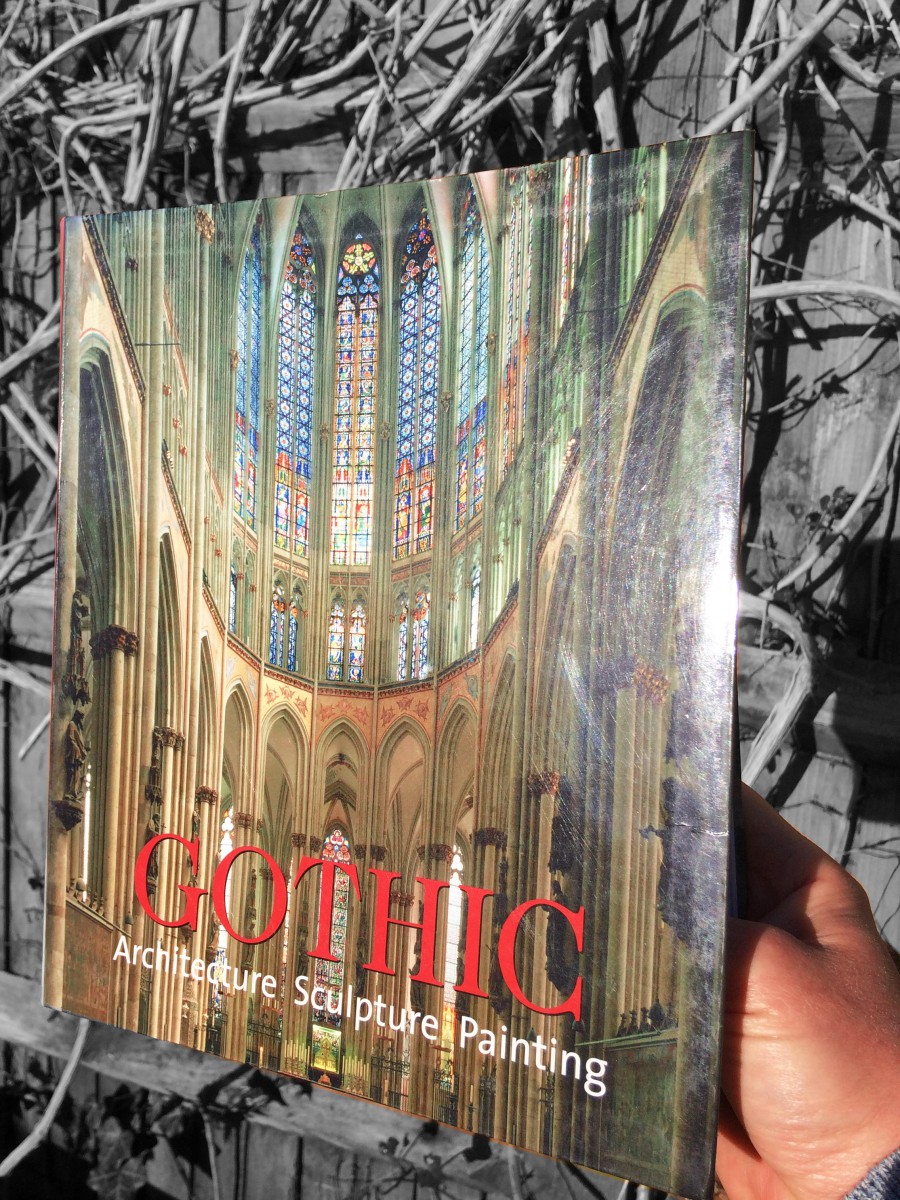
This book has been for me a great resource that helped me better understand the Gothic movement in art from the 12th century to the Renaissance. An architectural style that first originated from France and spread all over Europe.
Over 500 pages it focuses on the development of Gothic architecture with many illustrations and photographs, but not only. I’ve also found interesting the in-depth discussion of the most diverse art forms, including painting, sculpture, metalwork and even book illumination! It also includes specific coverage of the Cathars’ Heresy and the Papal Palace in Avignon. And, of course, it mentions the cathedral of Notre-Dame d’Amiens!
This is definitely the book I recommend if – like me – you love everything about Gothic such as churches, gargoyles, stained glass, flying buttresses and so much more.
Facts and Figures
The following facts and figures show why the cathedral Notre-Dame d’Amiens ranks among the greatest churches of France.
- Total length: 145 m (Reims: 149,17 m, Notre-Dame de Paris: 130 m)
- Length of the West front: 48.78 m (Rouen: 61.60, Reims: 48.80)
- Height of nave: 42 m (Beauvais: 48 m, Metz: 41.41 m)
- Towers height: 68.19 m and 61.70 m (Strasbourg: 142 m, Orléans: 88 m, Reims: 81.50 m)
- Height of the spire: 112.70 m (Rouen: 151 m, Reims: 87 m)
- Total floor area: 7,700 m2 (Reims: 6,640 m2)
- Diameter of the West front rose window: 11 m (13.1 m for the transept roses in ND de Paris, 12.5 m in Reims)
The exterior of Amiens Cathedral
It’s from Place Notre-Dame that you can admire the magnificent West front of Amiens Cathedral.
You can also have interesting glimpses of the cathedral from Place Saint-Michel (on the chevet), Parc de l’Evêché, Rue Robert de Luzarches (on the transept) and, further away, from the picturesque Rue de la Dodane.
The Western Façade
Unlike the one of Chartres, the great façade of Amiens Cathedral appears particularly much decorated.
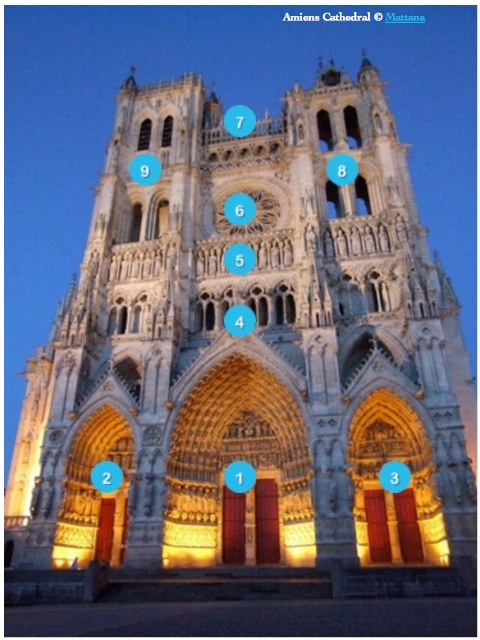
- Portals
- Saint Firmin Portal
- Portal of the Virgin
- Triforium formed by a series of twin arcades
- Gallery of Kings
- Rose Window (redesigned in the 16th C in Flamboyant Gothic style).
- “Galerie des Sonneurs” added by Viollet-le-Duc in the 19th C.
- South Tower
- North Tower
The elevation levels of the cathedral of Amiens
It is also “in harmony”, meaning it includes three portals, three elevation levels and two towers.
The elevation levels are:
- The portals,
- the Gallery of Kings surmounting a triforium formed by a series of twin arcades,
- and the rose window (redesigned in the 16th century in Flamboyant Gothic style).
Then at the top are the two towers that architect Viollet-le-Duc linked together with the “Gallery of Bell Ringers” in the 19th century. This curtain wall, covering the area between the two towers, is surmounted by a second gallery containing exquisite ornamental archways.
The façade is vertically divided by four very strong buttresses. They separate and securely frame the three portals. Their presence ensures the stability of both the façade and the two towers that it supports.
The triangular gable
A triangular gable surmounts each of the three portals, with its centre decorated with clovers. You can notice on the right like on the left two remarkable gargoyles positioned at the base of these gables.
An angel statue sounding the trumpet surmounts the great gable of the central portal. Viollet-le-Duc changed the original statue of St Michael slaying a dragon.
Behind these galleries, you’ll find the “Room of Musicians” terrace. It contains some beautiful statues, the “Musician Kings”.
Portals of the Western Façade

The three portals of the western façades are, left to right:
- Portal of Saint-Firmin
- the central portal or Portal of the Last Judgement
- Portal of the Virgin
Like the one of the south transept, the portals of the western façade are lavishly decorated of sculptures. They display quite a theological program.
Proofs of polychromy
The portals have been cleaned during the 1990s with a procedure using a laser. This technique has helped discover and preserve traces of polychromy. Studies have shown that this polychromy had an unsuspected range in very vibrant shades (red, blue, green…).
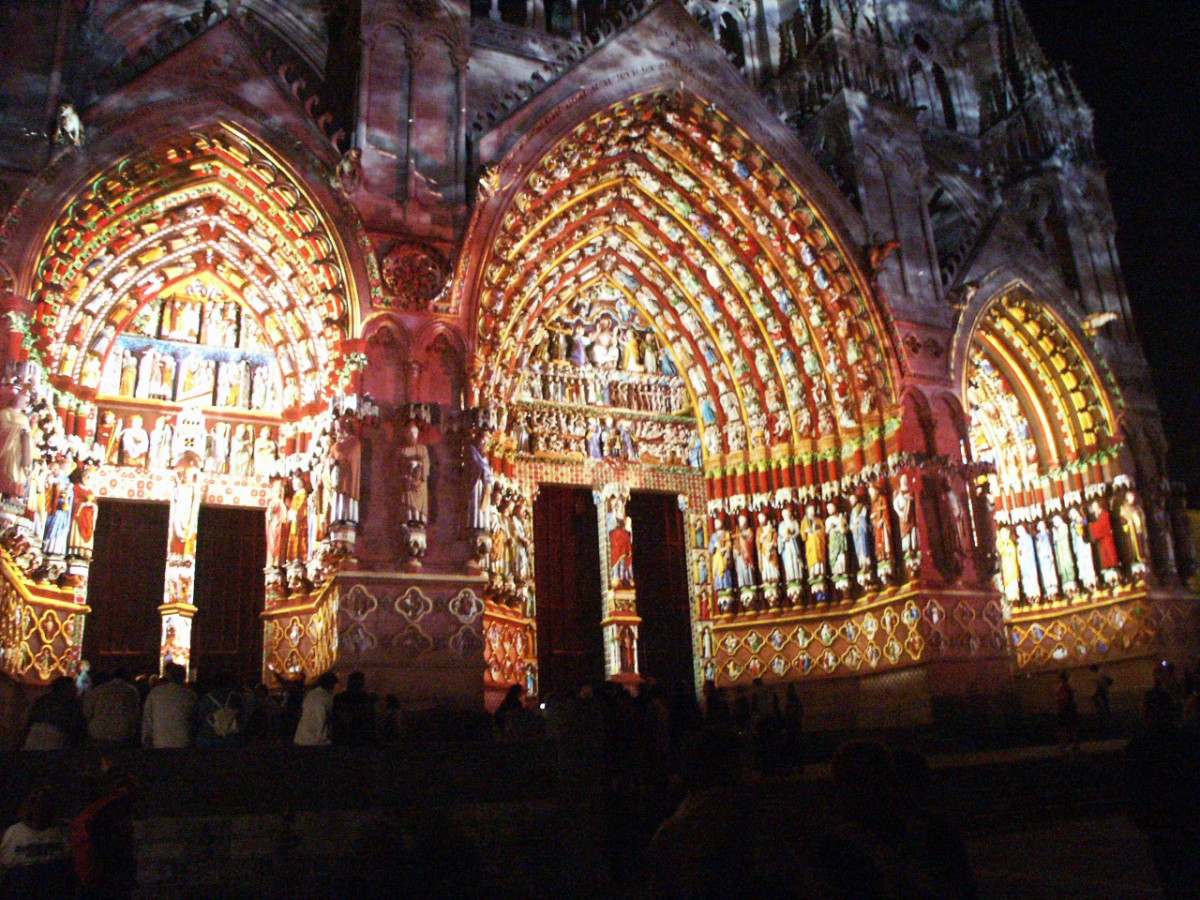
Since then, a free sound and lighting show has been held at the end of the year and in the summertime on the parvis of Amiens Cathedral. It reveals what the coloured façade of the cathedral looked like in the Middle Ages.
Central Portal

The tympanum features a depiction of the Last Judgement in three tiers:
- The lower level of the tympanum: the resurrected leave their graves at the sound of the trumpet. Standing in the middle, the archangel Saint Michael weighs the souls with his scales. At the bottom of the scene, a demon attempts to cheat by leaning one of the pans on his side.
- The intermediate tier: the elected are separated from the fully naked damned that are pushed by demons towards the jaw of a monster, the Leviathan.
- The upper tier: Christ on his throne, with raised hands and a bare torso in order to show his injuries, is surrounded by the Virgin and Saint John who are kneeling and intercede on behalf of the salvation of the soul and angels carrying the Instruments of the Passion.
The Lower Arch-Stones
Hell and heaven are depicted in the lower arch-stones of the tympanum arches.
- In heaven, souls gathered in the bosom of Abraham are then directed to a city representing heavenly Jerusalem.
- In hell, a pot and naked horsemen are perched on rearing horses, evoking the Apocalypse. This depiction is very similar to the one of Notre-Dame de Paris.
The Beau Dieu d’Amiens at the trumeau
At the trumeau of the central portal is a remarkable statue. It represents Christ the Saviour and takes the affectionate name of “Beau-Dieu d’Amiens”.
Standing and wearing a long tunic, his feet on a dragon and a lion, he holds in his left hand a closed book while blessing with his right hand.
According to the legend, the sculptor was uninspired to create the statue. God would have appeared before him in the middle of the night. The next morning, the sculptor was found dead with the statue of the Beau-Dieu by his side.
The statues of the splays
On the piers of the splays are the large statues of the twelve apostles. The four great prophets surround them.
The Saint Firmin Portal and the Picardy Calendar
![St Firmin Portal © Welleschik, licence [CC-BY-SA-3.0], from Wikimedia Commons](https://frenchmoments.eu/wp-content/uploads/2012/12/Amiens-Cathedral-2.jpg)
The north portal is dedicated to Saint Firmin. You’ll see him on the trumeau. The tympanum of the portal conveys the story of how his body was found.
There are six large statues on each side of the portal. Most of them are saints whose relics have been displayed every year above the high-altar.
The bases of the Saint Firmin portal are lavishly ornate. They contain the famous “Picardy Calendar” or “Amiens Zodiac”. It is an ensemble of beautiful sculptures, eight centuries old and remarkably well preserved. A series of medallions sculpted in a quatrefoil shape show the agrarian calendar which establishes a link between the zodiac and the work for the month. The depicted characters work in the country fields and wear different clothes according to seasons.
Portal of the Virgin

Also known as the Portal of the Mother of God, this portal is dedicated to the Virgin Mary.
On the trumeau is a depiction of the Virgin crushing Evil. The latter takes the shape of a mythic animal with a human face. The static stance of the Virgin is a trend on statues inspired by the Chartres model (from Chartres Cathedral).
The base of the trumeau comprises of bas-relief carvings of the original sin. The association of this theme and the Virgin is similar to that on the trumeau of the Virgin Portal in Notre-Dame de Paris.
On the tympanum:
- The lower tier depicts a series of six characters from the Old Testament,
- the middle tier shows the Death and the Assumption of the Virgin,
- and the top tier depicts the Crowning of the Virgin in heaven.
The statues that decorate the splays of side piers are particularly remarkable:
- To the right, the statues grouped in pairs represent three important events in the life of the Virgin Mary: the Annunciation, the Visitation and the Presentation of Jesus at the Temple.
- To the left, from the exterior to the interior are Queen Sheba, King Solomon, King Herod the Great and the three Wise Men.
The medallions at the bases represent scenes of the life of Christ but also of the kings at the left of the portal: Solomon (and Queen Sheba), Herod (and the three Wise Men).
The Lower Gallery and the Gallery of Kings

On top of the three portals is the lower gallery dating from 1235. It features a lavish decoration of archways and small columns. This gallery is lined with large openings which lit the central nave of the cathedral… however before the installation of the great organ.
The Gallery of Kings stands just above the lower gallery some 30 metres above the parvis.
The Gallery of Kings
There are 22 statues in the Gallery of Kings. However, the truth is that it is not certain whom these statues depict!
They date back to the first half of the 13th century.
- The central part of the façade has eight statues 3.75 metres high.
- Six other statues stand on the western side at the base of each of the arcades,
- while two are in the front of the central buttresses of the façade.
Curiously these statues appear relatively badly proportioned with their short limbs in comparison to their big head.
There are galleries reminiscent of Notre-Dame de Reims and Notre-Dame de Paris Cathedrals (although their statues date back to the 19th century only).
The Gallery of Kings supports an open and paved terrace. The heads of the long gargoyles that decorate the top of the Gallery of the Kings drain outwardly water from the pavement.
The West Rose Window
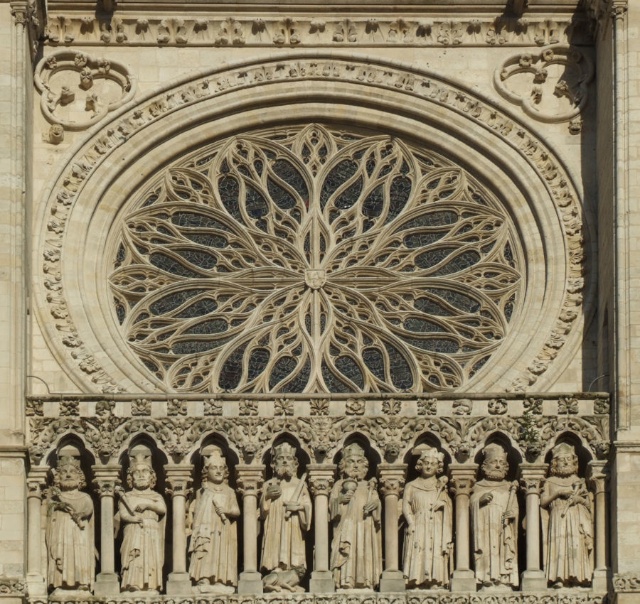
Just above the central part of the Gallery of Kings and its paved terrace is the magnificent rose window.
This Flamboyant Gothic style rose window dates from the 16th century. The mayor of Amiens ordered its design in the style of the time. It carries the surname of “The Rose of the Sea”.
Interestingly you can’t see the rose window in its entirety from the outside as the ledge of the terrace balustrade covers the lower part.
The Towers of Amiens Cathedral
The towers of Amiens Cathedral lack size and rather resemble parts of a tower.
Unlike those of the Rouen and Chartres façades, the small size of the towers at Amiens Cathedral does not contribute to the upward thrust of the building.
It is the spire of the transept, more than 100 metres high and visible from afar, which fulfils this role instead.

Why the towers of Amiens Cathedral are not taller?
The reason lies in the history of the cathedral construction:
- The towers were the last parts of the structure to build
- A lack of financial means prevented their elevation.
The upper parts of the towers date from the 14th and 15th centuries, They are not of equal height:
- 68.19 m high for the north tower, and
- 61.70 m high for the south tower.
The top of the south tower is of a Rayonnant Gothic style while the north tower is of a Flamboyant Gothic style. On their sides is a little quadrangular turret at the side buttresses, each containing a spiral staircase.
It is possible to climb the towers at Amiens Cathedral. When you reach the top, you will have an unobstructed view on the monument, particularly on the gargoyles and chimeras, and the city of Amiens.
The Statuary of Amiens Cathedral
The high parts of Amiens Cathedral have plentiful amounts of medieval sculptural works. They are often over-the-top or frightening, such as gargoyles, chimeras and Musician Kings.
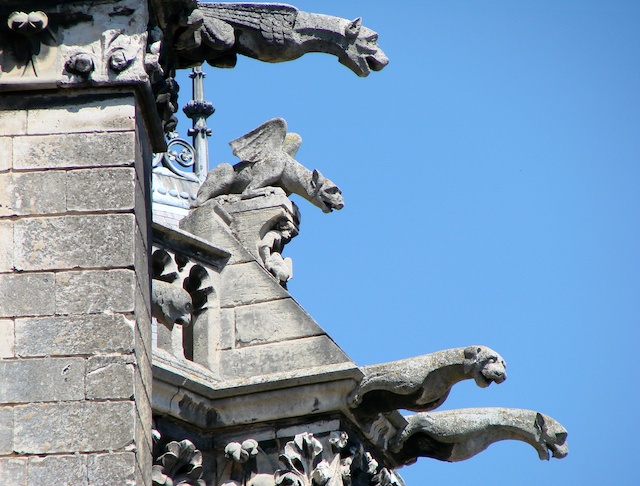
What’s the difference between gargoyles and chimeras?
There are countless gargoyles at the top parts of the cathedral. Often they are very high and are real pieces of statuary. It is important not to confuse gargoyles and chimeras.
Frightening gargoyles!
Gargoyles find their places at the end of the gutters to drain rainwater from the roof. They go over the edge to drain the water as far as possible from the cathedral walls. Therefore for the protection of the walls from water damage. With opened mouths, gargoyles often take the form of mythical animals that are frightening and fierce. Designed by many artists who were given artistic freedom, these creatures are all different and have a variety that is close to infinite.
Terrifying chimeras!
Chimeras, in contrast to gargoyles, do not have a purely decorative function. They are simply mythical, diabolical and often grotesque statues. They often have closed mouths and are perched on mounts that elevate them. We find them in the heights of the cathedral, on balustrades or at the top of buttresses where they replace pinnacles. The chimeras have a duty to watch over the city, like the famous mythical animals of Notre-Dame de Paris, added by Viollet-le-Duc.

The Musician Kings statues
Unlike chimeras, the statues of the Musician Kings represent very pleasant characters. Observer them with binoculars over all the roofs of the cathedral. You’ll spot a large number of them just behind the towers of the western façade, around the terrace of the “Chamber of Musicians”. This roof terrace is between the Gallery of Bell Ringers and the western end of the attic of the nave. Spot more of the Musician Kings (and easily) at the top of the buttresses of the axial chapel (chevet of the cathedral just behind the choir).
The South Façade of the Transept

The south façade of the transept rises towards the sky at a height of almost 60 metres. Two strong side buttresses surround it.
The South Transept consists of three elevation levels:
- the portal of Saint-Honoratus,
- the huge stained glass window,
- and at the top, the pediment.
The portal of the south transept arm bears the name of the portal of Saint-Honoratus. It also takes the name of the portal of the Golden Virgin, due to the statue that adorns its trumeau. The 2.30 m tall statue is actually an identical casting of the original one. The original copy from 1288 found shelter inside the cathedral in 1980 away from bad weather and pollution.
The tympanum recounts various events in the life of Saint-Honoratus, the eighth bishop of Amiens, who lived in the 6th century.
The North Façade of the Transept

The façade of the north transept arm has much less decoration than its southern counterpart. In fact, there are no statues or sculptures apart from the statue of St. Firmin on the trumeau.
The portal of St. Firmin the Confessor takes its name from Firmin II, third bishop of Amiens, (2nd half of the 4th century).
The Chevet of Amiens Cathedral

How surprising is the extremely elegant chevet of Amiens Cathedral! The strong structure has three floors of windows and a series of buttresses and flying buttresses.
Decoration includes gables, statues, gargoyles and pinnacles. This ensemble gives the impression of a powerful thrust towards the sky.
The interior of Amiens Cathedral
This spectacular video shot with a drone reveals the stunning interior of Amiens Cathedral:
This map of the cathedral should make it easy to understand where are the major features inside the cathedral:

The Nave
![Nave © Guillaume Piolle, licence [CC-BY-SA-3.0], from Wikimedia Commons.](https://frenchmoments.eu/wp-content/uploads/2012/12/Amiens-Cathedral-3-2.jpg)
The cathedral’s architects started with the nave. They built it in a very short time (1220-1236).
The elevation of the nave (like the choir) has three levels:
- large archways,
- the triforium,
- and high windows.
Light comes in through the high windows and the great rose window of the façade, the “Rose of the Sea”.
The nave covers an area of seven bays and is lined on each side with an aisle containing square vaults. Its height under the vault is 42.3 metres, the second in France behind Beauvais Cathedral (48m), but ahead of Metz Cathedral (41.77m) and Chartres Cathedral (37m). As to the columns along the nave, they are 13.85 metres high.
Amiens Cathedral is 145 metres long in total (the longest in France) and the nave is 54 m long.
The Labyrinth
![Labyrinth © Wi1234, licence [CC-BY-SA-3.0], from Wikimedia Commons.](https://frenchmoments.eu/wp-content/uploads/2012/12/Amiens-Cathedral-4.jpg)
Unlike Reims Cathedral, Amiens has preserved its labyrinth. Work from the 12th century, it is an octagonal geometric shape engraved across the whole width of the main nave’s pavement, at the fifth bay.
The labyrinth appeared to be a symbolic road where man meets God. The centre of this great design would therefore symbolise heavenly Jerusalem or the hereafter.
Its path measures 234 metres. The pilgrims who came to venerate the relics of John the Baptist that were brought back in 1206, had the tradition of walking along with it on their knees by following the black line.
The central stone of the labyrinth contains an inscription on a copper strip and summarises the groundwork of the cathedral. The stone is actually a copy. The original dating from 1288 is on display at the Museum of Picardy.
The paving of the nave has a series of designs restored in the 19th century. They include, among others, the swastika pattern.
The Transept
![Crossing Vaults, Amiens Cathedral © Guillaume Piolle, licence [CC-BY-SA-3.0], from Wikimedia Commons.](https://frenchmoments.eu/wp-content/uploads/2012/12/Amiens-Cathedral-41.jpg)
The transept of the cathedral enjoys a sumptuous decoration.
The two arms of the transept each have three bays and two side aisles, one to the west and the other to the east.
The elevation of the transept has three levels, like the nave and the choir:
- large archways overlooking the side aisles,
- a transparent triforium,
- and high windows.
A large stained glass window with a rose window lit each transept arm:
- The rose window of the south transept arm, the “Rose of Heaven”, is of a Flamboyant Gothic style
- The rose window of the north transept arm, or “Compass Rose” is of a Rayonnant Gothic style.
The relics of John the Baptist
![St John the Baptist Relic © Amanda Slater, licence [CC-BY-SA-3.0], from Wikimedia Commons](https://frenchmoments.eu/wp-content/uploads/2012/12/Amiens-Cathedral-2-3.jpg)
In the north transept arm, you can notice a 12th-century basin. It was used to wash deceased people. A relic consisting of a small splinter of cranial bone is on display in a wooden chest with glass. According to tradition, it belonged to John the Baptist.
As for the entire skull, it is on display in the Treasury of Amiens Cathedral near the sacristy. The relic is the only thing remaining from the Revolutionaries’ destruction.
Legends have it that Wallon de Sarton, a canon from Picquigny, brought back the skull of John the Baptist in 1206 during the Fourth Crusade.
The Choir and the Ambulatory
![Choir of Amiens Cathedral © Florestan, licence [CC-BY-SA-3.0], from Wikimedia Commons](https://frenchmoments.eu/wp-content/uploads/2012/12/Amiens-Cathedral-5.jpg)
A wrought-iron gate surrounds the choir of Amiens Cathedral. The choir includes four bays, as well as a seven-sided apse. The latter is enclosed by a simple ambulatory in which are seven Rayonnant chapels.
Like the one of the nave, its elevation has three levels:
- large archways,
- the triforium,
- and high windows.
In the axis of the choir, you can see in the central high window a large colourful stained glass window. It was offered to the cathedral in 1269. It is the most beautiful and important stained glass window of the cathedral. Its theme is the Angels announcing the coronation of St. Louis.
Apse chapels surround the choir with superb sculptures from different periods (from the Middle Ages to Louis XVI …).
![Cathedra, Amiens Cathedral © Guillaume Piolle, licence [CC-BY-SA-3.0], from Wikimedia Commons.](https://frenchmoments.eu/wp-content/uploads/2012/12/Amiens-Cathedral-61.jpg)
To the left of the choir is the cathedra of the cathedral, of Baroque style.
Apsidal chapels with high ceilings border the ambulatory.
The stalls
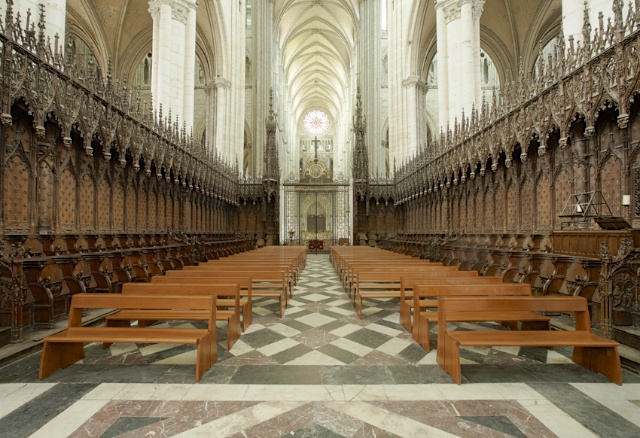
The incredible choir stalls of Amiens cathedral represent the biggest masterpiece of cabinet work (with those of Toledo Cathedral).
These stalls of Flamboyant Gothic style were built with blond oak over 11 years, from 1508 to 1519. They consist of more than 4,000 characters originally spread over 120 stalls (110 today with 62 high and 48 low stalls).
The two major stalls were unique in France with a huge 13.50 m wooden lace above them.
On one sat the King and on the other the dean of the chapter.
On the King’s stall sat Louis XII, Francis I, Henri IV, then Napoleon I and French President Charles de Gaulle.
More info about the monument!
Here are a few websites and blogs about Amiens Cathedral that you might find useful:
- on the blog: explore Beauvais Cathedral
- the official website of the cathedral of Amiens [in French only]
- the website for the 800th anniversary of the cathedral in 2020
- the website of the Amiens Tourist Board
- the site of Centre des Monuments Historiques for climbing to the cathedral’s Towers.
- to book your accommodation in Amiens, click on this affiliate link which will redirect you to our partner booking.com
- Wikipedia’s article on Amiens Cathedral
The cathedral is open every day from 7.30 am to 7.30 pm (7.15 pm on Sunday and celebration days). No visits on Sunday morning from 9 am-12 pm during masses. The entrance is free.
Things to do in Amiens and Picardy
Looking for activities and things to do in Amiens and the surrounding region of Picardy? Check out the offers from our partner Get Your Guide:
Pin it for later
Liked what you read? Pin it on Pinterest:





